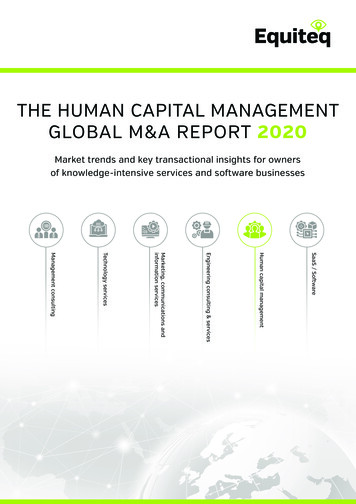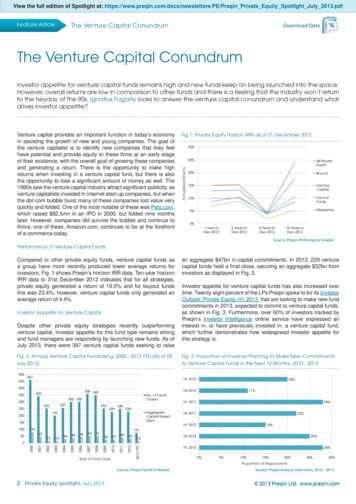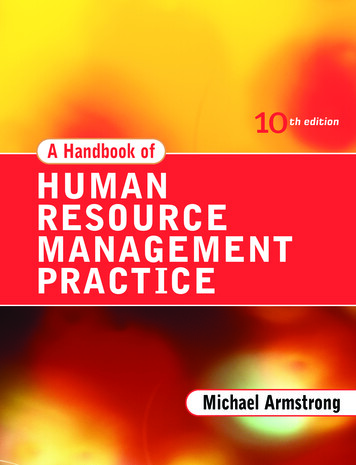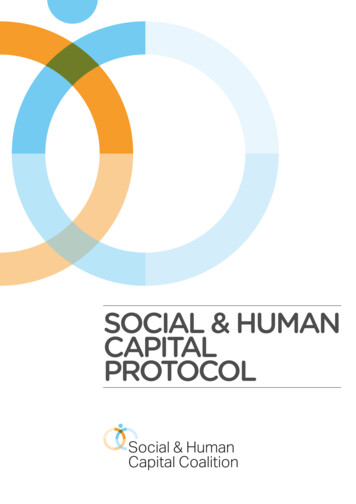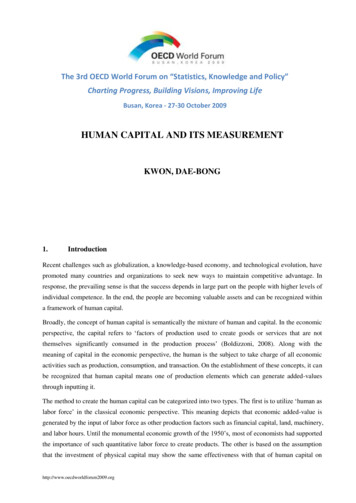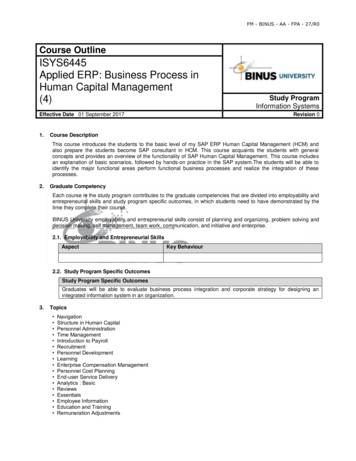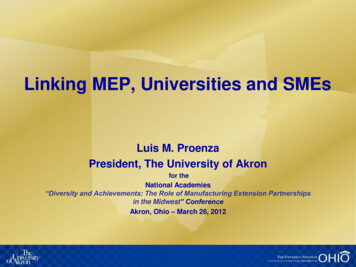
Transcription
Review of Economic Studies (2010) 01, 1–32c 2010 The Review of Economic Studies Limited 0034-6527/10/00000001 02.00How Important is Human Capital?A Quantitative Theory Assessmentof World Income Inequality1A. EROSAMadrid Institute for Advanced Studies (IMDEA), C/Isaac Newton, 2 Primera Planta,Parque Tecnolgico de Madrid, 28760 Tres Cantos (Madrid), España.E-mail: andres.erosa@imdea.orgT. A. KORESHKOVADepartment of Economics, Concordia University,1455 de Maisonneuve Blvd. West Montreal, QC, H3G 1M8, Canada.E-mail: tkoreshk@alcor.concordia.caD. RESTUCCIADepartment of Economics, University of Toronto,150 St. George Street, Toronto, ON M5S 3G7, Canada.E-mail: diego.restuccia@utoronto.caFirst version received February 2007; final version accepted December 2009 (Eds.)We build a model of heterogeneous individuals who make investments in schoolingquantity and quality to quantify the importance of differences in human capital versusTFP in explaining the variation in per-capita income across countries. The production ofhuman capital requires expenditures and time inputs; the relative importance of these inputsdetermines the predictions of the theory for inequality both within and across countries.We discipline our quantitative assessment with a calibration firmly grounded on U.S. microevidence. Since in our calibrated model economy human capital production requires asignificant amount of expenditures, TFP changes affect disproportionately the benefits andcosts of human capital accumulation. Our main finding is that human capital accumulationstrongly amplifies TFP differences across countries: To explain a 20-fold difference in theoutput per worker the model requires a 5-fold difference in the TFP of the tradable sector,versus an 18-fold difference if human capital is fixed across countries.1. INTRODUCTIONWhile economists consider human capital a crucial component of aggregate wealth, theyhave conflicting views on the importance of differences in human capital versus totalfactor productivity (TFP) in accounting for income differences across countries. In this1. The authors would like to thank seminar and workshop participants at Queens University,Arizona State University, ASU Development Workshop, HEC Montreal, University of Montreal, FederalReserve Bank of Richmond, 2006 NBER Summer Institute Growth Workshop, McGill University,University of Texas-Austin, University of Southern California, Bank of Canada Productivity Workshop,Concordia University, Carleton University, University of Tokyo, Seoul National University, WashingtonUniversity in St. Louis, Yale University, University of Pennsylvania, 2007 SAET Conference, University ofSouthampton, University of Edinbugh, and Universidad Carlos III de Madrid. Andrés Erosa acknowledgesfinancial support from the European Commission through Marie Curie International ReintegrationGrants PIRG03-GA-2008-231096. The paper has previously circulated under the title “On the Aggregateand Distributional Implications of Productivity Differences Across Countries.”1
2REVIEW OF ECONOMIC STUDIESpaper, we develop a quantitative theory of human capital investments to quantify theimportance of differences in human capital versus TFP in explaining the variation in percapita income across countries. Building a quantitative theory allows us to circumventtwo major problems faced by growth accounting exercises. First, to date, there are noreliable cross-country measures of the quality of schooling across countries. If this qualityis positively associated with the level of economic development, the residual in growthaccounting exercises overstates the cross-country differences in TFP. A second problemarises due to the (unobserved) covariance of TFP with measures of physical and humancapital, which renders output variance decomposition difficult. Developing a quantitativetheory, in turn, is a challenging task due to the lack of conclusive micro-evidence on theparameters of the human capital technology.In light of these difficulties, our paper provides a novel approach to studying incomedifferences across countries: We build a model of heterogeneous individuals who makeinvestments in schooling quantity and quality and use a broad set of micro factsto discipline the key parameters of the human capital technology. Motivated by theempirical studies of Neal and Johnson (1996) and Keane and Wolpin (1997), we focus oninvestments that take place “early” in the life of an individual and formulate a dynasticmodel of parental investments in the human capital of their children. Individuals areheterogeneous in terms of ability, schooling tastes, and parental resources. Individualsacross countries face different wage rates and prices for human capital inputs. The model’smain novelty relative to previous work in the area is the inclusion of a productiontechnology for human capital which takes expenditures and time as inputs.1 The relativeimportance of these inputs determines the predictions of the theory for inequality bothwithin and across countries.2 The intuition is simple: If schooling requires only timeinputs, a change in the ability of individuals or in the wage rate affects equally thebenefits and the costs of human capital accumulation, leaving the optimal level of humancapital unchanged. On the other hand, when schooling requires only the input of goods,an increase in ability or in the wage rate raises benefits but not the costs of schooling,hence increasing the optimal human capital stock.We discipline our quantitative assessment with a calibration firmly grounded onU.S. micro evidence. We exploit the fact that the parameters governing human capitalaccumulation have important consequences for schooling and earnings inequality andintergenerational mobility within a country. Hence, we use U.S. household data to pindown the key parameters elasticities of human capital with respect to time and goodsinputs driving the quantitative implications of the theory across countries. Our baselineeconomy successfully matches a large number of calibration targets on schooling andearnings inequality in the U.S., such as the variances and intergenerational correlationsof earnings and schooling, and the slope coefficient and R2 in a Mincer regression. Themodel economy is also consistent with several dimensions of heterogeneity in the data thatwere not targeted in the calibration: schooling distribution, evidence on the relationshipbetween schooling attainment of children and resources/background of their parents,and results in the micro literature on the enrollment effects of college tuition changes.1. Manuelli and Seshadri (2005) and Cordoba and Ripoll (2007) follow a similar approach.2. Bils and Klenow (2000) point out that the production of human capital is more intensive inthe time input than the production of output goods. They and Klenow and Rodriguez-Clare (1997)argue that, by using a one-sector growth model, Mankiw et al. (1992) overstate the importance of goodsinput in the production of human capital and, thus, obtain results that understate TFP differences acrosscountries. The idea that the specification of the human capital technology has important implications forinequality within a country was developed by Erosa and Koreshkova (2007) in the context of a taxationexercise.
EROSA ET AL.HOW IMPORTANT IS HUMAN CAPITAL?3Altogether, the paper provides an important contribution to the literature by developinga successful theory of inequality in schooling and earnings in the U.S. economy.We use the calibrated model economy to quantitatively assess how variations in TFPare amplified through human capital accumulation into large differences in output perworker across countries. We assume that countries are identical in terms of preferencesand technologies and only differ in their level of TFP. Following Hsieh and Klenow (2007)and Herrendorf and Valentinyi (2009), we model sectoral productivity differences acrosscountries. Relative to the benchmark economy, we assume that a one percent reductionon the TFP of the manufacturing (tradable) sector is associated with a 0.3 percentreduction in the TFP of the service (nontradable) sector. This assumption allows themodel economy to match the cross-country variation on the price of services relative tomanufacturing.Our main finding is that human capital accumulation strongly amplifies TFPdifferences across countries: The elasticity of output per worker at PPP prices with respect to TFP in the tradable sector is 1.94. This implies that a 5-fold differencein TFP explains a 20-fold difference in the output per worker, as is observed betweenthe top 10 percent and bottom 10 percent of countries in the world income distribution.In contrast, when we solve a version of the model without human capital accumulation,an 18-fold difference in the TFP of the tradable sector is required to account for theincome difference between rich and poor countries. Two main channels explain whyhuman capital provides substantial amplification. First, our calibration implies a largeshare of expenditures in the human capital production function, which means that areduction in TFP affects disproportionately the benefits and costs of human capitalaccumulation. Hence, while the benefit of obtaining human capital is proportional toTFP, the cost of education (relative to the price of output) is less than proportionalto TFP. This mechanism accounts for the low schooling quantity and quality in poorcountries. Second, human capital is an important source of income differences acrosscountries, not only because it directly contributes to cross-country output differences,but also because a lower human capital stock discourages physical capital accumulationby lowering the marginal product of capital.Finally, we provide several pieces of evidence that support the main predictionsof the theory. First, we show that the cross-country differences in schooling impliedby our theory are plausible. Second, we use our model to simulate immigrants in theU.S. and find that some (modest) degree of selection into immigration can reconcile thequality differences in education predicted by our theory with the data on earnings ofU.S. immigrants. Third, we show that our theory is consistent with data on relative pricevariation across countries. Using data from the International Comparisons Program (ICP)we show that the elasticity of the price of education relative to output is quantitativelyclose to the elasticity implied by our simulations. The evidence supports the idea thatthe cost of education (relative to the price of output) does not rise proportionally withTFP, which is the main mechanism emphasized by our theory.3The paper proceeds as follows. The next section describes in detail the economicenvironment. In section 3, we consider a simple version of the model in order to illustratethe main features of our theory driving human capital investments and to motivateour calibration strategy. Section 4 lays out the calibration strategy for the benchmark3. As pointed by one referee, the small elasticity of the price of education with respect to outputis obtained despite the fact that the ICP cannot take into account unmeasured quality differences ineducation across countries.
4REVIEW OF ECONOMIC STUDIESeconomy and shows that the model economy is consistent with several dimensions ofheterogeneity in the data that were not targeted in the calibration. Furthermore, thepredictions of the benchmark economy are tested using results from the micro literatureon the enrollment effects of college tuition changes. In section 5, we evaluate the aggregateimpact of TFP differences across countries, examine the predictions of the theory for thevariation in relative prices across countries, and compare our findings to related papersin the literature. Section 6 concludes.2. ECONOMIC ENVIRONMENTWe consider an economy populated by overlapping generations of people who arealtruistic toward their descendants and invest in the human capital of their children.4Investments in human capital involve children’s time and expenditures by parents thataffect the quality of the human capital of their children. Parents cannot borrow to financeinvestment in human capital. Since the analysis in this paper focuses on steady states,time subscripts are omitted in the description of the model and use a prime to indicatethe next period value of a given variable.2.1. Demographic StructureThere is a large number of dynasties (mass one). Individuals live for three periods, sothat the model period is set to 20 years. An individual is referred to as a child in thefirst period of his life (real age 6-26 years), a young parent in the second period (real age26-46 years), and an old parent in the third period of his life (real age 46-66 years).5 Ahousehold is composed of 3 people: old parent, young parent, and a child.2.2. Production TechnologiesWe assume that production takes place in two sectors manufacturing and services with the following technologies:1 ααYM AM KMHM,α 1 αYS AS KS HS(2.1)(2.2)where YM and YS denote the output of the manufacturing and service sectors; Ki andHi represent the services of physical and human capital used in sector i {M, S}. Theparameter α (0, 1) is the elasticity of output with respect to physical capital and isassumed to be equal across sectors. The parameter Ai , i {M, S}, represents sectoralTFP, which is allowed to vary across sectors.Manufacturing output can be consumed (CM ) or invested in physical capital (X).Services can be either consumed (CS ) or invested in human capital (ES ). FeasibilityrequiresCM X YM ,CS E YS .4. This approach is motivated by some empirical studies of earnings inequality. Keane and Wolpin(1997) find that 90 percent of the variance of lifetime utility is accounted for by heterogeneity in skillsof individuals at age 16, i.e. prior to labor market entry. Similarly, Neal and Johnson (1996) find thatparental investments are crucial for explaining differences in skill attainments of their children.5. In an earlier version of the paper, we modeled a retirement period. Since it did not affect thequantitative implications of the theory, we decided to abstract from retirement in the current version ofthe paper.
EROSA ET AL.HOW IMPORTANT IS HUMAN CAPITAL?5Physical capital is accumulated according to K (1 δ)K X, where investment goodsX are produced in the manufacturing sector.We model human capital investments as taking place ‘early’ in the life of anindividual and that include schooling as well as investments outside of formal schooling.Consistent with the view of Becker and Tomes (1986), Haveman and Wolfe (1995), Nealand Johnson (1996), Mulligan (1997), Keane and Wolpin (1997, 2001), among manyothers, we think that households invest a lot of resources in their children outside ofschool (health, food, shelter, books, recreational activities and extracurricular educationalactivities). This view motivates our focus on a broad notion of human capital investments.The human capital of a child is produced with the inputs of schooling time (s [0, 1])and expenditures in human capital quality (e 0) according to the following productionfunction: ξ η, ξ [0, 1].(2.3)hc AH z sη e1 η ,A unit of schooling time (quantity of schooling) is produced with one unit of a child’stime and l units of market human capital services. In other words, schooling requires owntime and human capital purchased in the market.6 Educational expenditures in qualityare assumed to be in terms of services.7To model heterogeneity across individuals, we follow the micro literature in allowingindividuals to differ in terms of their ability z and their taste for schooling θ. We assumethat the shocks to z and θ are idiosyncratic to each dynasty and that they are observedat the beginning of the period, that is, before human capital investments take place. Theability z is transmitted across generations according to a discrete Markov transitionmatrix Q(z, z ), where qi,j P r(z zi z zj ). The taste shock θ is iid acrossindividuals and, possibly, correlated with the current realization of the ability shockz. The distribution of the taste shock is thus described by a discrete matrix Qθ (z, θ).The parameter AH in the human capital production function (2.3) is common across allindividuals in the economy and is normalized to 1 in our baseline economy.82.3. PreferencesThe per-period utility function of the household is 1 σ1 (CM )γ (CS )1 γ υ(s, θ),1 σwhere CM represents consumption of manufacturing goods and CS consumption ofservices. The term v(s, θ) represents utility of schooling, where θ is a taste shock thatvaries across individuals. Thus, consistent with the micro literature on schooling (see,for instance, Keane and Wolpin (2001) and Card (2001)), in our model heterogeneityin schooling decisions is driven by variation not only in parental wealth and labormarket returns (ability) but also in schooling tastes. We model many sources of schoolingvariation across individuals because our calibration will target the variance in schooling inthe US economy. Had we assumed that individuals only differ in ability, our calibration6. Schooling s is a Leontief function of own time t and market human capital services hs :s min{t, hs }.l7. In Erosa et al. (2009), we allow for educational expenditures to be a composite of manufacturinggoods and services.8. In Erosa et al. (2009), we consider cross-country variation in the efficiency of the human capitaltechnology by allowing the parameter AH to vary across economies (Klenow and Rodriguez-Clare (1997)allow for the possibility that countries differ in the productivity of the education sector.)
6REVIEW OF ECONOMIC STUDIESwould have exaggerated the elasticity of schooling decisions to variation in ability. Inthis case, our results would have likely overestimated the response of human capitalinvestments to TFP, since in our theory differences in ability across individuals operatesimilarly to differences in TFP across countries.2.4. Market Structure and Relative PricesWe assume competitive markets for factor inputs and outputs. Profit maximization inthe manufacturing and services sectors imply PS AAM, where we have set the price ofSmanufacturing goods to 1 (numeraire).The optimal allocation of total expenditure C between consumption ofmanufacturing goods CM and services CS solves the static problemc(C) max (CM )γj (CS )1 γjCN ,CTs.t. C PS CS CM .Optimal behavior implies that total consumption expenditures C Pc c, where Pc 1 γj(PS )γγj j (1 γj )1 γj(PS )1 γjγjγj (1 γj )1 γjc .2.5. Public EducationSince our calibration strategy is to use cross-sectional heterogeneity within a countryto restrict the parameters governing human capital accumulation, we cannot abstractfrom the effects of public education on education and labor market outcomes. We modelpublic education by assuming that education expenditures are subsidized at the rate pper unit of schooling time. These expenditures are financed with a proportional tax τon households’ income. Public and private expenditures are perfect substitutes in theproduction of human capital.2.6. Decision Problem of the HouseholdAll decisions of the household are made by the young parent. The state of a youngparent is given by a quadruple (q, hp , z, θ): resources (disposable income and assets) ofthe old parent q, human capital of the young parent hp , child’s ability z, and child’staste for schooling θ. Households face uncertainty over the realization in future periodsof ability, school taste and market luck, hence, they maximize the expected discountedlifetime utility of all generations in the dynasty. Young parents choose consumption c,assets a , time spent in school by their children s (where 1 s is the working time of thechildren), and resources spent on the quality of education of their children e. A parentwho provides his child with s years of schooling and a quality of education e incursl p)s, where w l is the cost of market human capital services perexpenditures PS e (w year of education, and p denotes public education expenditures (or subsidies) per yearof education.
EROSA ET AL.HOW IMPORTANT IS HUMAN CAPITAL?7The decision problem of a young household can be written using the language ofdynamic programming as follows: V (q, hp , z, θ) max Ξ(z, θ, z , θ , μ )V (q , μ hc , z , θ ) ,U (c) υ(s, θ) βc,e,s,h ,a z ,θ ,μ(2.4)subject tol p)s a (1 τ )w [ψ2 hp ψ1 hc (1 s)] q,Pc c PS e (w ξhc AH z sη e1 η ,q (1 τ ) [wψ3 hp ra] aa 0, s [0, 1], where Ξ(z, θ, z , θ , μ ) Qz (z, z )Qθ (z , θ )Qμ (μ ) and (ψ1 , ψ2 , ψ3 ) are life-cycleproductivity parameters. The first two terms in the objective function are current periodutility and the third term is expected discounted future utility. The expectations ofthe next period’s value function is taken over the market luck of the current child μ and over the ability z and school taste θ of the child born in the next period. Thefirst constraint is the household budget constraint, where the right-hand side is givenby the sum of the earnings of the young parent and the child upon finishing school(1 τ )w[ψ2 hp ψ1 hc (1 s)]) and the resources q (after tax earnings and gross assetreturn) brought to the current household by the old parent. The third constraint definesthe parental wealth q of the next household in the dynasty line.We emphasize that when young parents make education decisions for their children,they know the ability z and the taste for schooling θ. However, they face uncertaintyregarding the market luck of their children μ , which is realized in the adult stage ofthe individual’s life cycle. The human capital hc of an individual at the end of the firstperiod of life evolves stochastically, according to a realization of a market luck shockμ : hp μ hc , where μ is iid across individuals and time according to a density Qμ (μ)with a mean equal to 1. For tractability reasons and motivated by the empirical crosscountry evidence,9 our theory abstracts from on-the-job human capital accumulation.We assume that markets are imperfect in that households cannot perfectly insure againstlabor-market risk and the human-capital shocks affecting their descendants. Moreover,individuals cannot borrow.3. HUMAN CAPITAL INVESTMENTS IN A COMPLETE MARKETSENVIRONMENTThis section provides some analytical results that shed light on how the parameters of thehuman capital technology determine the quantitative implications of the theory. To studya simplified version of the model economy, we assume complete markets and abstract fromtastes for schooling. As a result, human capital investment decisions are independent ofconsumption decisions and maximize lifetime income. We show that the quantitative9. Using the coefficients for returns to experience for each country reported in Bils and Klenow(2000), we found that the earnings of a worker with 20 years of experience relative to a worker with 10years of experience is not systematically related to the level of per-capita income across countries. Infact, we found a small negative correlation between returns to labor market experience (wage growth)and per-capita income across countries, which suggests that on-the-job investments in human capital arenot likely to be an important source of income differences across countries.
8REVIEW OF ECONOMIC STUDIESimplications of the theory for income inequality within and across countries dependcrucially on the expenditure elasticity of human capital. We also study how cross-countrydifferences in sectoral productivities generate heterogeneity in relative prices and humancapital investments.3.1. Human capital investments across individuals and countriesConsider a world with a large number of countries. Each country is populated by measure1 of dynasties and by a vector of prices (w, PS ) that varies across countries. Capitalmarkets are assumed to be perfect so that in equilibrium individuals make efficientinvestments in human capital. Attention is confined to a steady-state analysis. Theequilibrium interest rate is given by individuals’ rate of time preference ρ. Although thetheory makes no predictions for the distribution of income, consumption, and wealth,it does have important implications for the variation of schooling and earnings acrossindividuals and countries.3.1.1. The decision problem. We analyze how variation in wages and variationin ability (z) lead to heterogeneous human capital investments across countries (derivemacro elasticities) and across individuals (derive micro elasticities). The goal is to isolatethe effects of the parameters of the human capital technology on micro and macroelasticities in our model.Consider the decision problem of an individual with ability z in a country with a wagerate w and a price of education services PS , where these prices are expressed in termsof the manufactured good. The human capital investment decision can be formulated aschoosing schooling time (s) and expenditures (e) to maximize the present value of thelifetime earnings net of the education costs:max w(1 s)hψ1 whΨ PS e w ls(3.5)e,s,hs.t.where Ψ 3i 2 ξ h AH z sη e1 η ,(3.6)β i 1 ψi with ψi representing the life cycle productivity parameters1described in the previous section, and β 1 rprovided r ρ. The cost of schoolingincludes expenditures in human capital quality (e), time-purchases on the market (tuitioncosts) per unit of schooling time (w l), and foregone earnings in the first period of life(swhψ0 ).Assuming an interior solution, the first-order conditions can be expressed as: ξηξ[(1 s)ψ1 Ψ] l̄AH z sη e1 η(3.7) ψ0 s e wAH z (1 η) ξ [(1 s)ψ1 Ψ] sηξPS1 1 (1 η)ξ.(3.8)In the absence of tuition costs (l̄ 0), it is easy to solve for s from (3.7) and verifythat the optimal quantity of schooling does not vary across individuals with differentvalues of z. Intuitively, when there are no tuition costs of schooling (l̄ 0) a changein z raises proportionally the benefits and costs of schooling and has no effect on theoptimal choice of years of schooling. Moreover, when l̄ 0, there is no variation in
EROSA ET AL.HOW IMPORTANT IS HUMAN CAPITAL?9schooling across countries (w, pS ). We thus maintain l̄ 0. Similarly, in the absence ofeducation expenditures (η 1), the quality of schooling does not vary across individualsand countries. On the contrary, when 0 η 1, equations (3.7) and (3.8) imply thatboth quantity and quality of schooling vary across individuals (z) and countries (w, PS ).Proposition 1: The theory requires l̄ 0 and 0 η 1 in order to generatedifferences in the quantity and quality of schooling across individuals (z) and countries(w, PS ).3.1.2. Micro-elasticities. To gain insights with simple algebra, it is convenientto set ψ1 0. Combining (3.7) and (3.8), taking logs, and differentiating with respect toln z, gives an expression for the individual (ability) elasticity of schooling:Esz ln(s)1 . ln z1 ξ(3.9)The elasticity of expenditures with respect to ability is obtained by differentiating (3.8)with respect to ln z: 1 ln(e) ln(s)1 ,(3.10)Eez 1 ηξ ln z1 (1 η) ξ ln z1 ξwhere the last equality used (3.9). The elasticity of human capital with respect to theability, is obtained by log-differentiating (3.6) with respect to ln z and by using (3.9) and(3.10):1.Ehz 1 ξTaking stock of the above findings, we note that the elasticities of schooling and humancapital with respect to ability are all the same. The magnitude of this elasticity isdetermined by the returns to scale in the human capital accumulation technology(parameter ξ). For a given distribution of z in the population, variation in both schoolingand human capital increase with the returns-to-scale parameter ξ. Hence this parameteris important for the predictions of the theory on the cross-sectional inequality in schoolingand earnings.3.1.3. Macro-elasticities. Combining (3.7) and (3.8), taking logs, anddifferentiating with respect to ln w, we obtain the cross-country (wage) elasticity ofschooling:(1 η)ξ ln(s) .(3.11)Esw ln w1 ξUsing (3.11), the variation in the schooling quality across countries (w) satisfies 1 ln(e)(1 η)ξEew 1 ηξ.(3.12) ln w1 (1 η) ξ1 ξLog-differentiating (3.6) with respect to ln w, together with (3.11) and (3.12), givesEhw (1 η) ξ.1 ξ(3.13)Since Ehw does not vary across individuals, aggregation is trivial: If two countriesdiffer in TFP by a ratio AR , then their ratio of aggregate human capital is: HR (WR )EhA dGz (WR )EhA . We conclude that EHw Ehw (1 η)ξ1 ξ . Table
10REVIEW OF ECONOMIC STUDIESTABLE 1Elasticities in the Deterministic ModelMacroEHw Ehw Esw Eew 11 (1 η)ξ (1 (1 η)ξ1 ξ2ξ η(1 η))1 ξMicroEsz Ehz Eez 11 ξfor x {s, e, h}Ex,PS Ex,wEx,w/PS Ex,w1 summarizes the mapping from the model parameters into the micro and macroelasticities.We are now ready to explore the sensitivity of the wage elasticity of human capitalto the parameters of the human capital technology. Since Ehw increases with the returnsto-scale parameter ξ and decreases with the time share parameter η, Ehw increases withthe expenditure elasticity of human capital and is maximized when η 0 and ξ 1.As the time-share parameter η decreases from 1 to 0, EHw takes values in the intervalξ]. For instance, when ξ .9, EHw takes values between 0 and 9, depending on[0, 1 ξthe time-share parameter. In other words, a wage ratio of 3 can generate differences inhuman capital per worker anywhere from a factor of 0 to 20 000.10Proposition 2: The amplification effect of human capital, given by (3.13), dependscrucially on the expenditure elasticity of human capital (1 η) ξ. In particular, if theexpenditure share is zero (η 1), then human capital does not amplify TFP differencesacross countries, no matter how close ξ is to 1.Countries differ not only with respect to the wage rate but also w
versus an 18-fold difference if human capital is fixed across countries. 1. INTRODUCTION While economists consider human capital a crucial component of aggregate wealth, they have conflicting views on the importance of differences in human capital versus total factor productivity (TFP) in accounting for income differences across countries .
